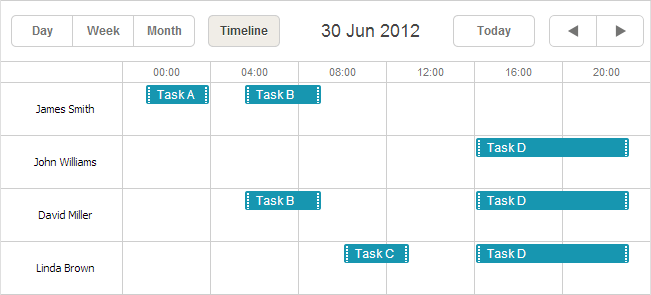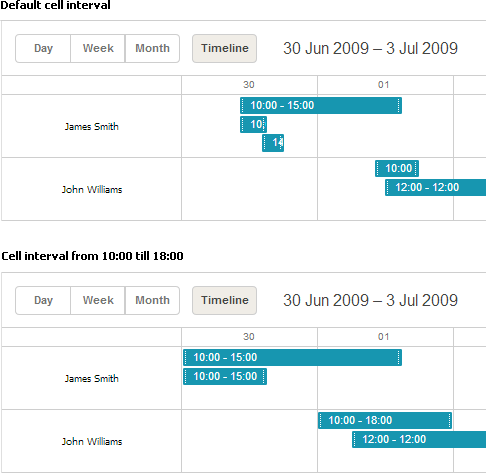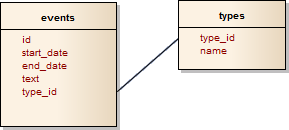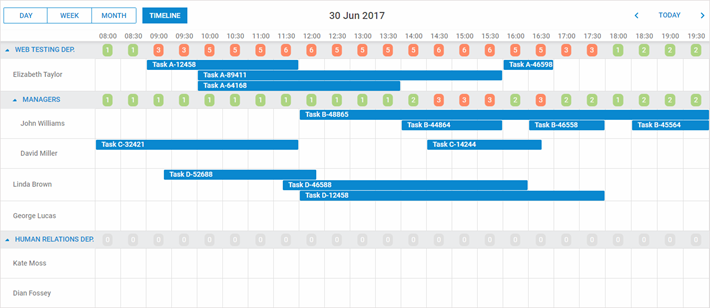Available only in PRO Edition
타임라인 뷰
이 뷰는 Scheduler PRO 버전에만 포함되어 있습니다.
타임라인 뷰는 이벤트를 수평으로 표시하며, 각각의 타임라인을 좌우로 나란히 배치합니다.

초기화
스케줄러에 타임라인 뷰를 추가하려면 다음 단계를 따르세요:
- 페이지에서 Timeline 확장 기능을 활성화하세요:
- Timeline - 'Bar' 및 'Cell' 모드용
- Timeline, Treetimeline - 'Tree' 모드용
- Timeline, Daytimeline - 'Days' 모드용
scheduler.plugins({ timeline: true, treetimeline: true, daytimeline: true });
- 스케줄러의 마크업에 뷰 탭을 추가하세요:
<div id="scheduler_here" class="dhx_cal_container" ...> <div class="dhx_cal_navline"> ... <div class="dhx_cal_tab" name="timeline_tab" style="right:280px;"></div> </div> ... </div>
- 탭의 라벨을 설정하세요:
//'timeline_tab'은 div의 이름을 참조합니다 scheduler.locale.labels.timeline_tab ="Timeline";
- createTimelineView 메서드를 호출하세요:
scheduler.createTimelineView({ name:"timeline", x_unit:"minute", // X축의 단위 x_date:"%H:%i", // X축에 표시되는 날짜 포맷 x_step:30, // X축 단위의 간격 x_size:24, // X축에 표시되는 'x_step'의 총 개수 x_start:16, // X축 시작 오프셋 (x_unit 기준) x_length:48, // 한 번에 스크롤되는 'x_step'의 개수 y_unit: // Y축에 표시되는 섹션 [{key:1, label:"Section A"}, {key:2, label:"Section B"}, {key:3, label:"Section C"}, {key:4, label:"Section D"}], y_property:"section_id", // 데이터를 섹션에 매핑하는 속성 render:"bar" // 뷰 모드 });
'Days' 모드를 사용할 때, 타임 스케일은 반드시 정확히 하루를 포함해야 합니다. 설정이 더 짧거나 길면 타임라인이 올바르게 렌더링되지 않습니다.
스케일 구성 예시
createTimelineView 메서드는 많은 파라미터를 포함하고 있지만, 실제로는 간단합니다.
예시: 09:00부터 15:00까지 30분 간격으로, 하루 단위로 스크롤되는 타임 스케일.

{
x_unit:"minute",// 스케일 단위는 분
x_step:30, // 30분 간격, 예: 09:00 - 09:30
x_size:12, // 09:00~15:00까지 30분 구간의 개수
// 15 - 9 = 6시간 = 360분 = 360/30 = 12
x_start:18, // 스케일 시작은 09:00, 즉 00:00으로부터 9시간
// 9시간 = 540분 = 540/30 = 18 'x_step'
x_length:48,// 하루 스크롤: 1일 = 24시간 = 1440분 = 1440/30 = 48 'x_step'
...
}
타임라인 뷰 구성
이름에 {timeline}_some이 포함된 모든 템플릿 함수는 뷰를 생성한 후에 정의해야 합니다. 이러한 함수들은 타임라인 생성자에 의해 동적으로 할당되며 createTimelineView 호출 시 덮어쓰기 때문입니다.
타임라인 뷰의 시작 날짜 설정
예를 들어, 타임라인 뷰의 시작 날짜를 설정하는 방법은 다음과 같습니다.
모든 뷰의 시작 날짜는 scheduler.date[
// 주의 시작을 월요일로 설정
scheduler.config.start_on_monday = true;
// 타임라인 뷰 생성
scheduler.createTimelineView({
name: "timeline",
render: "tree",
days: 7,
folder_dy: 20,
x_unit: "day",
x_date: "%D %j %F",
x_step: 1,
x_size: 7,
x_start: 0,
x_length: 7,
y_unit:[],
y_property: "section_id"
});
// 생성 후 시작 날짜 함수 오버라이드
scheduler.date.timeline_start = scheduler.date.week_start;
// 스케줄러 초기화
scheduler.init("timeline_tree", new Date(), "timeline");
타임라인 객체 API
타임라인 뷰와 상호작용할 수 있는 여러 메서드가 제공됩니다.
타임라인 뷰 생성
스케줄러에서 타임라인 인스턴스를 생성하세요:
scheduler.createTimelineView({
name:'timeline',
...
});
var timeline = scheduler.matrix.timeline;
생성 후 아래의 메서드들을 사용할 수 있습니다.
타임라인 뷰 가져오기
타임라인 뷰 객체를 가져오려면 getView 메서드를 사용하세요. 뷰의 이름을 파라미터로 받습니다. 파라미터가 없으면 현재 뷰를 반환합니다.
var timeline = scheduler.getView();
timeline.x_size = 8;
scheduler.setCurrentView();
스케일 범위 설정
setRange() 메서드를 사용하여 스케일 범위를 정의할 수 있습니다. 두 개의 파라미터가 필요합니다:
- startDate - (Date) 범위 시작
- endDate - (Date) 범위 끝
timeline.setRange(startDate, endDate);
왼쪽 패널의 컬럼 지정
왼쪽 패널의 내용은 두 가지 방법으로 설정할 수 있습니다.
기본적으로는 하나의 컬럼만 포함합니다. 섹션 라벨은 y_unit 객체의 label 속성에서 가져오며, timeline_scale_label 템플릿으로 커스터마이즈할 수 있습니다.
여러 컬럼을 정의하려면 createTimelineView 메서드에서 columns 속성을 사용하세요:
scheduler.createTimelineView({
name: "timeline",
x_unit: "minute",
x_date: "%H:%i",
x_step: 30,
x_size: 24,
x_start: 16,
x_length: 48,
y_unit: sections,
event_dy: "full",
y_property: "section_id",
render:"bar",
columns: [
{ label: "Room #", width: 70, template: function(obj){ return obj.room_no; } },
{ label: "Type", width: 90, template: function(obj){ return obj.room_type; } },
{ label: "Status", width: 90, template: function(obj){ return obj.room_status; } }
]
});
각 컬럼 객체는 다음 속성을 가질 수 있습니다:
- label -
string- 헤더 라벨(선택) - width -
number- 컬럼 너비(선택) - template -
function- 섹션 객체를 받는 셀 템플릿 함수
Related sample: Timeline Sidebar columns
특정 위치/날짜/섹션으로 스크롤
이 기능은 타임라인에서 수평 스크롤이 활성화된 경우에만 동작합니다.
특정 지점으로 스크롤하려면 scrollTo() 메서드를 사용하세요. 다양한 파라미터 타입을 지원합니다:
- Date 객체를 전달하여 특정 날짜로 스크롤:
timeline.scrollTo(new Date());
- 픽셀 값을 전달하여 특정 위치로 스크롤:
timeline.scrollTo(500);
- 날짜와 섹션 키가 포함된 객체를 전달하여 수평 및 수직으로 특정 섹션의 특정 날짜로 스크롤:
timeline.scrollTo({date:new Date(), section:4});
- left와 top 픽셀 값이 있는 객체를 전달하여 수평, 수직 위치로 스크롤:
timeline.scrollTo({left:300, top:500});
특정 위치의 좌표 얻기
- 스케일에서 특정 날짜의 X좌표를 얻으려면 posFromDate()를 Date 파라미터와 함께 사용하세요:
var left = timeline.posFromDate(new Date());
이 메서드는 날짜가 스케일 범위를 벗어나면 0 또는 최대 X좌표를 반환합니다.
- 특정 행의 Y좌표를 얻으려면 getSectionTop()을 섹션 번호와 함께 사용하세요:
var top = timeline.getSectionTop(section.key);
행을 찾을 수 없으면 -1을 반환합니다.
- 타임라인 좌표에 해당하는 날짜와 섹션을 찾으려면 resolvePosition()을
{left: number, top: number}객체와 함께 사용하세요:
const position = timeline.resolvePosition({top: 120, left: 400});
- 시간 스케일의 특정 left 좌표에서
Date를 얻으려면 dateFromPos()를 사용하세요:
const date = timeline.dateFromPos(300);
- 특정 이벤트의 top 좌표를 얻으려면 getEventTop()을 이벤트 객체와 함께 사용하세요:
const top = timeline.getEventTop(scheduler.getEvent(event.id));
스크롤 위치 가져오기
현재 스크롤바 위치를 확인하려면 timeline.getScrollPosition()을 호출하세요. 스크롤 좌표가 담긴 객체를 반환합니다:
var timeline = scheduler.getView();
timeline.getScrollPosition(); // { left: 0, top: 0 }
반환 객체는 다음을 포함합니다:
- left - (number) 수평 스크롤 위치
- top - (number) 수직 스크롤 위치
onScroll 이벤트를 사용해 스크롤 변경을 감지할 수도 있습니다. 이 이벤트는 새로운 left, top 위치를 전달받습니다:
var timeline = scheduler.getView();
timeline.attachEvent("onScroll", function(left, top){});
특정 섹션에 할당된 이벤트 가져오기
특정 섹션에 할당된 이벤트 배열을 얻으려면 timeline.selectEvents()를 구성 객체와 함께 사용하세요:
{
section: string|number,
date: Date,
selectNested: boolean
}
설명:
- section - 섹션의 id
- date - 선택 사항, 지정한 날짜 컬럼에 겹치는 이벤트만 필터링
- selectNested - 선택 사항, true이면 섹션이 트리 타임라인 폴더일 때 모든 하위 섹션의 이벤트도 선택
이 메서드는 이벤트 객체 배열을 반환합니다.
var timeline = scheduler.getView();
var events = timeline.selectEvents({
section: section.key,
date: date,
selectNested: true
});
속성의 동적 변경
모든 타임라인 객체는 scheduler.matrix 객체에 저장됩니다. 이름으로 원하는 타임라인 뷰에 접근해 속성을 업데이트할 수 있습니다. 변경 사항은 스케줄러를 새로고침한 후 적용됩니다:
scheduler.getView('timeline').x_size = 12;
scheduler.setCurrentView(); // 스케줄러를 다시 그림
여기서 'timeline'은 createTimelineView 메서드에서 지정한 이름과 일치해야 합니다:
scheduler.createTimelineView({
name:'timeline',
...
});
섹션 동적 변경
타임라인 뷰에서 단위(유닛) 목록을 실시간으로 업데이트해야 할 때는 serverList 및 updateCollection 메서드 사용을 권장합니다.
데이터 로딩
Day, Month, Year와 같은 단순한 뷰와 달리, Units 및 Timeline과 같은 다중 리소스 뷰에서는 각 데이터 항목에 추가 필드가 반드시 포함되어야 합니다.
- y_property - (string) 이벤트를 특정 섹션에 할당하는 데 사용되는 데이터 프로퍼티를 지정합니다.

scheduler.createTimelineView({
name:"timeline",
...
y_unit:
[{key:1, label:"Room 1"},
{key:2, label:"Room 2"},
{key:3, label:"Room 3"}],
y_property:"room_id",
});
scheduler.init('scheduler_here');
scheduler.parse([
{text:"Conference", start_date:"17/09/2012 12:00", end_date:"18/09/2012 21:00",
room_id:"1"},
{text:"Meeting", start_date:"17/09/2012 09:00", end_date:"17/09/2012 21:00",
room_id:"2"},
{text:"Conference", start_date:"17/09/2012 15:00", end_date:"18/09/2012 15:00",
room_id:"3"}
]);
여러 섹션에 이벤트 할당
스케줄러는 하나의 이벤트를 여러 섹션에 동시에 할당하는 기능을 지원합니다.

이 기능을 활성화하려면:
- Multisection 확장 기능을 페이지에 포함합니다.
- multisection 속성을 true로 설정합니다.
- (선택 사항) "Multiselect" 확장 기능을 추가하여 스케줄러 내에서 편리하게 섹션을 전환할 수 있는 Multiselect 컨트롤을 제공합니다.
<script src="codebase/dhtmlxscheduler.js"></script>
<link rel="stylesheet" href="codebase/dhtmlxscheduler.css" type="text/css">
<script> scheduler.plugins({
multisection: true, multiselect: true,
timeline: true
});
scheduler.config.multisection = true; scheduler.init('scheduler_here');
</script>
설정 후, 이벤트의 관련 데이터 프로퍼티에 여러 섹션을 (기본적으로 쉼표로 구분하여, 자세한 내용은 section_delimiter 참고) 나열할 수 있으며, 해당 이벤트는 모든 지정된 섹션에 표시됩니다.
scheduler.createTimelineView({
name: "timeline",
y_unit: [
{key: 1, label: "James Smith"},
{key: 2, label: "John Williams"},
{key: 3, label: "David Miller"},
{key: 4, label: "Linda Brown"}],
y_property: "section_id", ...
});
scheduler.init('scheduler_here', new Date(2012, 5, 30), "timeline");
scheduler.parse([
{ id:1, text:"Task A", section_id:'1', ...}, { id:2, text:"Task B", section_id:'1,3', ...}, { id:3, text:"Task C", section_id:'4', ...}, { id:4, text:"Task D", section_id:'2,3,4', ...}]);
Related sample: Multisection events in Timeline and Units view
뷰 모드
타임라인 뷰는 네 가지 고유한 모드를 제공합니다:
- Bar

Related sample: Bar mode
- Cell (기본값)

Related sample: Cell mode
- Tree

Related sample: Tree mode
- Days

Related sample: Days as Timeline rows
원하는 모드는 render 파라미터로 선택할 수 있습니다.
scheduler.createTimelineView({
name: "timeline",
render: "bar"
});
'Days' 모드 상세
Days 모드를 사용할 때는 다음 사항에 유의해야 합니다.
- 타임 스케일은 반드시 하루를 정확히 커버해야 합니다. 더 짧거나 긴 기간으로 설정하면 타임라인이 올바르게 렌더링되지 않을 수 있습니다:
scheduler.createTimelineView({ name:"timeline", render:"days", days:7, //time scale configured to cover 1 day x_unit:"minute", x_date:"%H:%i", x_step:30, x_size:24, x_start:16 });
- 이 모드에서는 차단 및 표시 기능이 지원되지 않습니다.
-
Y축 레이블 형식은 scale_label 템플릿으로 제어할 수 있습니다:
scheduler.templates.timeline_scale_label = function(key, label, section){ // Day 뷰와 동일한 레이블 사용 return scheduler.templates.day_date(label); };
- 표시 구간의 시작일을 조정하려면 scheduler.date.{timeline_name}_start 함수를 사용하세요:
scheduler.date.timeline_start = function (date) { date = scheduler.date.week_start(date); date = scheduler.date.add(date, config.x_step*config.x_start, config.x_unit); return date; };
뷰 셀의 시간 간격
기본적으로 뷰의 각 셀은 하루 간격을 커버하며, 이벤트도 이에 맞게 배치됩니다. 이 간격을 사용자 정의하려면(예: 근무 시간만 집중하고 그 외 시간은 제외) 다음 중 한 가지 방법을 사용할 수 있습니다.
- first_hour 및 last_hour 파라미터 사용:
// 셀 간격을 10:00~18:00으로 제한
scheduler.createTimelineView({
name:"timeline",
first_hour:10,
last_hour:18
});
Related sample: Changing the time interval for the view cells
- ignore_{viewName} 함수 사용. 여기서 viewName은 createTimelineView로 생성한 타임라인 뷰의 name 옵션과 동일합니다. 이 함수는 셀 날짜를 인자로 받아, 제외할 시간대에 대해 'true'를 반환합니다:
// 셀 간격을 10:00~18:00으로 제한
scheduler.ignore_timeline = function(date){ // "timeline"은 뷰 이름
// 근무 외 시간 제외
if (date.getHours() < 10 || date.getHours() > 18) return true;
};
ignore_{viewName} 메서드에 대한 자세한 내용은 뷰의 X축에서 시간 단위 숨기기 섹션을 참고하세요.
Related sample: Hiding hours in the scale of Timeline view

제외되는 구간이 타임라인 전체 구간과 같거나 더 길면 적용되지 않습니다.
예를 들어, 타임라인이 하루 전체를 커버할 때 ignore_{viewName} 함수로 하루 전체를 제외하려 하면, 해당 날짜가 스케줄러에 표시되지만 스케일이나 이벤트는 렌더링되지 않습니다.
이런 구간을 완전히 제외하려면 scheduler._click.dhx_cal_next_button 함수 내에서 x_length 설정을 동적으로 조정해야 합니다. 예를 들어, 주말을 타임라인에서 완전히 건너뛰려면 다음과 같이 할 수 있습니다:
scheduler._click.dhx_cal_next_button = function(dummy,step){
var mode = scheduler.getState().mode;
var minDate = scheduler.getState().min_date;
var formFunc = scheduler.date.date_to_str("%D");
// 주말 건너뛰기
if(mode=='timeline'){
if((formFunc(minDate)=='Fri' && step!=-1) || (formFunc(minDate)=='Mon' && step==-1))
scheduler.matrix['timeline'].x_length = 24*3;
else
scheduler.matrix['timeline'].x_length = 24;
}
scheduler.setCurrentView(scheduler.date.add(
scheduler.date[scheduler._mode+"_start"](scheduler._date),(step||1),scheduler._mode));
};
Related sample: Ignoring weekends
'Bar' 및 'Cell' 모드의 Y축 섹션 데이터
'Bar' 및 'Cell' 모드에서 Y축 값을 정의하려면 y_unit 파라미터를 사용하세요.
scheduler.createTimelineView({
name:"timeline",
...
y_unit:[
{key:1, label:"James Smith"},
{key:2, label:"John Williams"},
{key:3, label:"David Miller"},
{key:4, label:"Linda Brown"}
]
});
각 y_unit 항목에는 다음 두 가지 필수 속성이 필요합니다.
- key - 항목의 고유 식별자
- label - 항목의 텍스트 라벨
'Tree' 모드의 Y축 섹션 데이터
'Tree' 모드를 사용하면 항목을 다단계 폴더로 그룹화할 수 있어, 조직이 더 체계적일 뿐 아니라 계층 내 어느 폴더에도 이벤트를 할당할 수 있습니다.
'Tree' 타임라인을 설정하려면 'Bar', 'Cell' 모드와 동일하게 y_unit 파라미터를 사용하되, 추가 속성을 포함시킵니다.
scheduler.createTimelineView({
name: "timeline",
render:"tree",
...
y_unit:[
{key:"production", label:"Production Department", children:[
{key:"p1", label:"Managers", children:[
{key:"pm1", label:"John Williams"},
{key:"pm2", label:"David Miller"}
]},
{key:"p2", label:"Linda Brown"},
{key:"p3", label:"George Lucas"}
]},
{key:"sales", label:"Sales and Marketing", children:[
{key:"s1", label:"Kate Moss"},
{key:"s2", label:"Dian Fossey"}
]}
]
});
y_unit 항목에는 다음과 같은 속성이 있습니다.
- 필수 두 가지:
- key - 항목 id
- label - 항목 라벨
- 선택 두 가지:
- open - 섹션이 처음에 펼쳐질지 여부
- children - 하위 항목 객체 배열
'Days' 모드의 Y축 섹션 데이터
'Days' 모드에서는 days 파라미터로 Y축에 표시할 일 수를 지정합니다.
scheduler.createTimelineView({
name:"timeline",
...
days:7 // Y축에 표시되는 일 수
});
서버에서 Y축 섹션 데이터 불러오기
서버에서 Y축 섹션을 불러오려면 다음과 같이 합니다.
- 클라이언트 측에서는 serverList 메서드를 사용:
scheduler.createTimelineView({
name:"timeline",
...
y_unit:scheduler.serverList("sections"),
});
여기서 serverList는 'sections'라는 옵션 목록을 불러옵니다.
- 서버 측
load 메서드의 응답에는 데이터 포맷 예시에서 설명한 대로 서버 리스트 이름의 컬렉션이 JSON 형식으로 포함되어야 합니다.
또는 OptionsConnector 커넥터를 사용할 수 있습니다.
<?php
include('connector-php/codebase/scheduler_connector.php');// 파일 포함
$res=mysql_connect("localhost","root","");// DB 서버 연결
mysql_select_db("sampleDB");// 데이터베이스 선택
$list = new OptionsConnector($res, $dbtype);
$list->render_table("types","type_id","type_id(value),name(label)");
$scheduler = new schedulerConnector($res, $dbtype);
// 클라이언트와 동일한 이름('sections')으로 지정
$scheduler->set_options("sections", $list);
$scheduler->render_table("events","id","start_date,end_date,text,type_id");
?>

응답은 JSON format의 "collections" 객체에 serverList에서 참조하는 컬렉션을 포함해야 합니다.
dhtmlxConnector를 사용하지 않고 컬렉션을 수동으로 생성할 수도 있습니다. 이 경우 컬렉션을 업데이트하려면 updateCollection 메서드를 사용하세요.
scheduler.updateCollection("sections", new_sections_array);
Related sample: Loading Units sections from the server
항목의 동적 추가/삭제
항목을 동적으로 추가하거나 제거하려면 다음 메서드를 사용할 수 있습니다.
scheduler.createTimelineView({
name: "timeline",
render:"tree",
...
y_unit:[
{key:"production", label:"Production Department", children:[
{key:"p1", label:"Managers", children:[
{key:"pm1", label:"John Williams"},
{key:"pm2", label:"David Miller"}
]},
{key:"p2", label:"Linda Brown"},
{key:"p3", label:"George Lucas"}
]},
{key:"sales", label:"Sales and Marketing", children:[
{key:"s1", label:"Kate Moss"},
{key:"s2", label:"Dian Fossey"}
]}
]
});
scheduler.addSection( {key:"pm3", label:"James Smith"}, "p1");
scheduler.addSection( {key:"s3", label:"Alex White"}, "sales");
scheduler.deleteSection("p3");
addSection 및 deleteSection 메서드는 스케줄러에서 'Tree' 타임라인 모드가 활성화되어 있어야 동작합니다.
두 번째 X축
기본 X축 위에 두 번째 X축을 추가하여 주 시간 간격을 그룹화할 수 있습니다.

두 번째 스케일을 추가하려면 second_scale 파라미터를 사용하세요.
scheduler.createTimelineView({
name: "timeline",
...
second_scale:{
x_unit: "day", // 축 단위 (기본값은 'minute')
x_date: "%F %d" // 날짜 형식 ("July 01")
}
});
Related sample: Second time scale (X-Axis)
이벤트 셀 전체로 늘리기
이벤트가 기간에 상관없이 셀 전체 너비를 채우도록 하려면 round_position 파라미터를 활성화하면 됩니다.
scheduler.createTimelineView({
name:"timeline",
render:"bar",
...
round_position:true
});
round_position:false (기본값)일 때:

round_position:true일 때:

이벤트 정렬
기본적으로 타임라인 뷰의 이벤트는 시작일 기준으로 정렬됩니다. 직접 정렬 기준을 지정하려면 sort 파라미터에 함수를 할당하세요.
이 함수는 인접한 두 이벤트를 받아 다음 값을 반환합니다.
- 1: 첫 번째 이벤트가 두 번째 이벤트보다 먼저 와야 함
- -1: 두 번째 이벤트가 첫 번째보다 먼저 와야 함
- 0: 두 이벤트가 동일하다고 간주
텍스트 길이로 정렬
scheduler.createTimelineView({
name: "timeline",
render:"bar",
...
sort:function(a, b){
if (a.text.length > b.text.length) {
// a가 b보다 먼저
return -1;
} else if(a.text.length < b.text.length) {
return 1;
} else{
return +a.start_date > +b.start_date ? 1 : -1;
}
}
});
수평 스크롤
타임라인 뷰는 네비게이션 버튼 없이도 일, 주, 월 단위로 수평 스크롤을 지원합니다.
수평 스크롤을 활성화하려면 createTimelineView 메서드에서 scrollable 속성을 설정하세요. column_width 및 scroll_position도 함께 설정할 수 있습니다.
scheduler.createTimelineView({
name: "timeline",
x_unit: "minute",
x_date: "%H:%i",
x_step: 30,
x_size: 24*7,
x_start: 16,
x_length: 48,
y_unit: sections,
y_property: "section_id",
render: "bar",
scrollable: true, column_width: 70, scroll_position:new Date(2018, 0, 15) });
- scrollable - (boolean) 수평 스크롤 활성화; 기본값 false. false 또는 미설정 시 컬럼이 타임라인 너비에 맞게 축소됩니다. true면 컬럼이 column_width 이하로 축소되지 않으며, 필요시 스크롤바가 나타납니다.
- column_width - (number) 옵션, 타임라인 날짜 컬럼의 최소 너비; 기본값 100.
- scroll_position - (Date) 옵션, 타임라인의 초기 스크롤 위치를 설정하며,
timeline.scrollTo()와 동일한 입력을 받습니다.
타임라인 뷰는 scrollable이 활성화되면 기본적으로 스마트 렌더링을 사용합니다. 이는 성능을 최적화하여 보이는 행, 열, 이벤트만 렌더링하고, 스크롤 시 나머지를 로드합니다.
Related sample: Horizontal scroll for Timeline view
타임라인 스크롤은 무한하지 않으며 시간 범위가 제한됩니다. 시간 구간 간 이동에는 네비게이션 컨트롤이 여전히 필요합니다.
오토스크롤 설정
타임라인 뷰포트 가장자리 근처에서 이벤트를 이동하거나 크기 조정시 오토스크롤이 기본적으로 활성화됩니다.
오토스크롤 민감도와 속도는 createTimelineView 메서드 내 autoscroll 객체로 조정할 수 있습니다.
scheduler.createTimelineView({
name:"timeline",
...
autoscroll: { range_x: 200, range_y: 100, speed_x: 20, speed_y: 10 } });
- range_x - (number) 수평 오토스크롤이 트리거되는 뷰포트 가장자리까지의 거리
- range_y - (number) 수직 오토스크롤이 트리거되는 뷰포트 가장자리까지의 거리
- speed_x - (number) 수평 오토스크롤 속도
- speed_y - (number) 수직 오토스크롤 속도
섹션 컬럼 헤더
기본적으로 섹션 컬럼 위의 헤더는 비어 있습니다. locale 객체를 사용해 라벨을 추가할 수 있습니다.
scheduler.locale.labels.<timelineName>_scale_header = "Label";
scheduler.locale.labels.timeline_scale_header = "Users";
셀 내 커스텀 콘텐츠
타임라인 셀 안에 커스텀 콘텐츠를 표시할 수 있습니다. Cell 모드뿐 아니라 모든 타임라인 모드에서 가능합니다.
모든 타임라인 모드에서 셀 콘텐츠 템플릿을 정의할 수 있습니다.

Related sample: Display labels in timeline cells
특정 타임라인에 대해 이 기능을 활성화하려면 createTimelineView에서 cell_template 속성을 true로 설정하세요.
scheduler.createTimelineView({
cell_template: true,
...
});
활성화 후에는 지정한 템플릿이 호출됩니다. 예를 들어 아래는 "tree" 타임라인 모드에서 날짜별 이벤트 수를 표시하는 예시입니다.
<style>
.dhx_matrix_cell div.load-marker{
position: absolute;
width: 40%;
height: 25px;
transform: translate(70%, 20%);
line-height: 25px;
text-align: center;
border-radius: 7px;
color: white;
}
.load-marker-no{
background: #e0e0e0;
}
.load-marker-light{
background: #aed581;
}
.load-marker-high{
background: #ff8a65;
}
</style>
scheduler.templates.timeline_cell_value = function (evs, date, section){
if(section.children){
var timeline = scheduler.getView();
var events = timeline.selectEvents({
section: section.key,
date: date,
selectNested: true
});
var className = "";
if(!events.length){
className = "load-marker-no";
}else if(events.length < 3){
className = "load-marker-light";
}else{
className = "load-marker-high";
}
return "<div class='load-marker "+className+"'>"+
events.length
+"</div>";
}
return "";
};
Related sample: Display labels in timeline cells
섹션 높이 변경
기본적으로 섹션과 이벤트의 높이는 createTimelineView의 dy 및 event_dy 설정으로 제어됩니다.
섹션 객체에 height 속성이 있으면 해당 값이 dy 설정을 덮어씁니다.
scheduler.createTimelineView({
name: "timeline",
...
y_unit: [
{key: 1, label: "Room 1", height: 60},
{key: 2, label: "Room 2", height: 60},
{key: 3, label: "Room 3", height: 120},
{key: 4, label: "Room 4", height: 900},
],
스케줄러 초기화 후에도 height 속성을 동적으로 변경할 수 있습니다.
Related sample: Collapse timeline rows